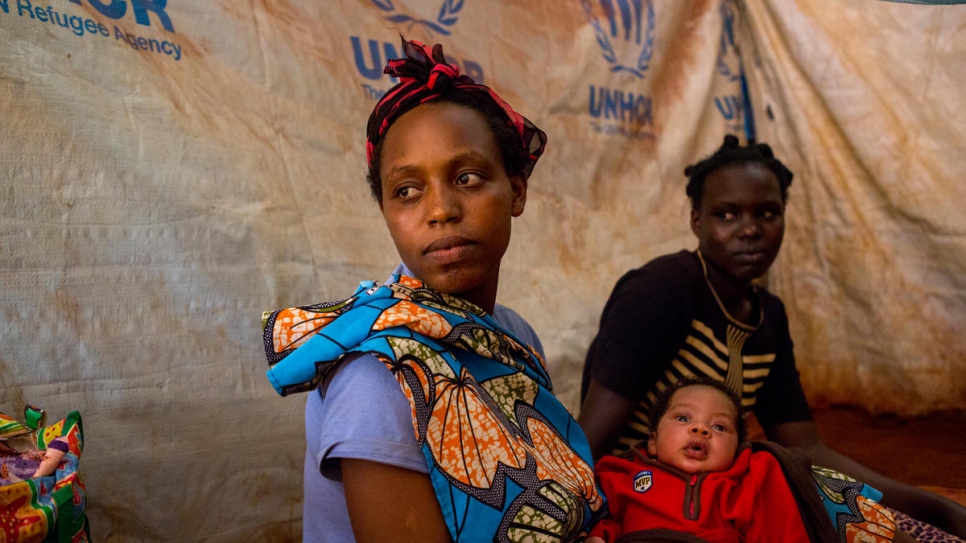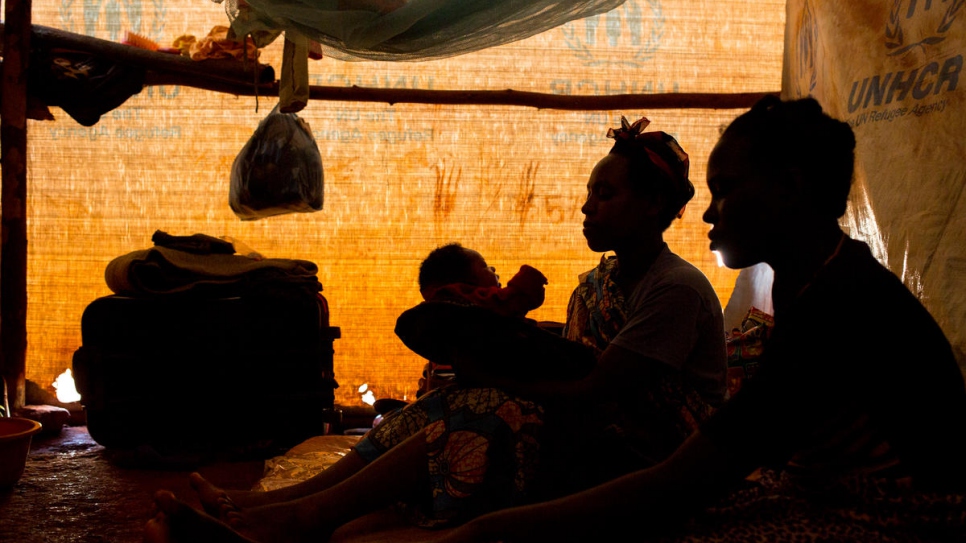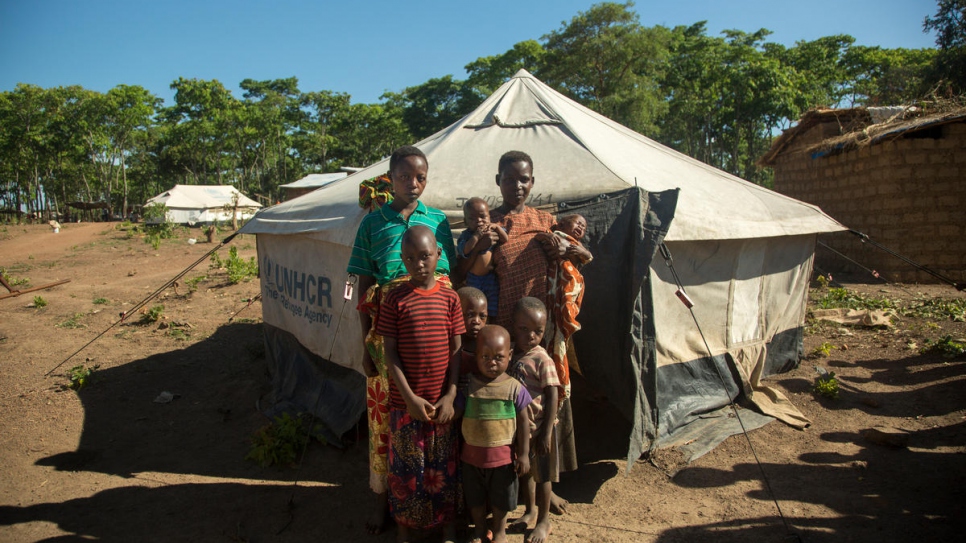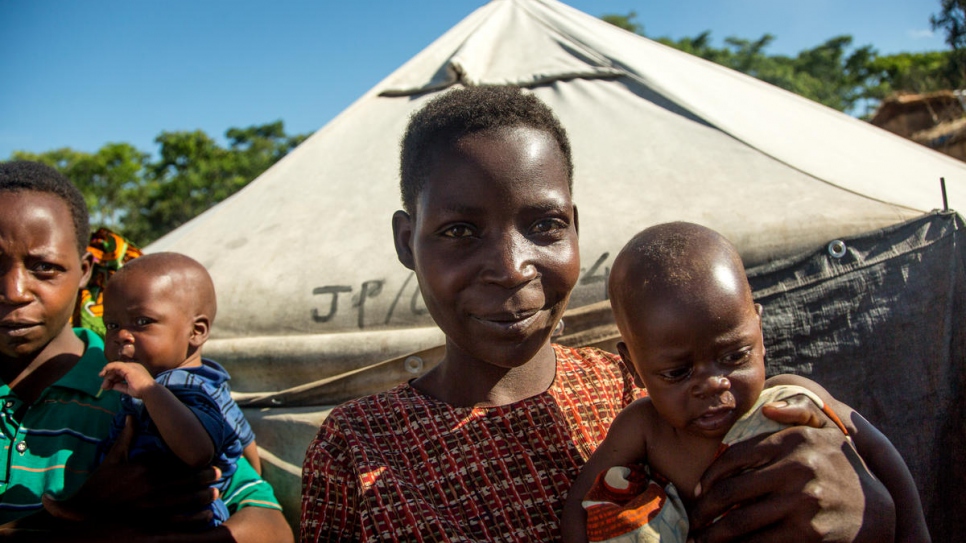Five months have passed since Sandrine Nyaribagiza first arrived at Nyarugusu refugee camp in north-western Tanzania. She thought she was safe after fleeing the Democratic Republic of the Congo (DRC). Now, in an overcrowded mass shelter only designed to accommodate new arrivals for a week, she fears for her family every night.
“Anyone can walk in,” says 21-year-old Sandrine, pointing to the loose canvas flap that gives access to the tiny section where she, her husband and their newborn baby sleep. “I’m still scared from before, and here I don’t feel any better. It doesn’t feel safe.”
Emergency shelters like these provide little comfort, privacy or security. Inside the huge tented structure, divided into about 30 dwellings, mosquitoes keep the inhabitants awake at night and intense heat builds up during the day. When it rains, water runs across the bare earth floor.
"There are so many diseases, we need better conditions.”
“My husband has gone to hospital,” says Sandrine. “He’s got stomach cramps and the flu. We don’t live properly. There are so many diseases, we need better conditions.”
One-month-old Promence’s hoarse cries confirm that she, too, has flu.
Nyarugusu camp opened more than 20 years ago and now accommodates nearly 150,000 refugees from the DRC and Burundi. Tanzania hosts a total of 359,494 people of concern, including refugees and asylum-seekers.
Further funding is urgently needed so that people like Sandrine and her baby can be moved quickly into safer, more solid structures. A growing shortfall means that, in the country’s refugee camps, hundreds of thousands of people are suffering. Better protected transitional shelters, costing US$500 each to build, are in short supply.
Chansa Kapaya, the Tanzania representative of UNHCR, the UN Refugee Agency, says that, by the end of the year, the agency and its partners hope to have built some 18,000 sun-dried mud brick transitional shelters with metal roofs. This is still only 38 per cent of what is needed. An additional 30,550 transitional shelters are required, at a total cost of about US$15,275,000.
“Refugees who fled their homes in Burundi and DRC and sought asylum in Tanzania lost everything and came with literally nothing,” she says. “Shelter is one of the many basic needs we try to provide every family. Adequate shelter is a basic human right and basic necessity that every human being requires. Providing adequate shelter for each refugee family is a big challenge due to funding constraints.”
In Nduta camp, which houses 125,000 refugees, three-quarters of the population are women and children. Only 34 per cent of households live in transitional shelters.
There, Venansiya Bigirimana, 28, and her sister Mariana Kamanzi, 30, have been living in a torn, dilapidated tent for 10 months since they arrived from Burundi. Nine people – the two sisters and their seven boys – share the cramped space. There are no beds, just the ground to sleep on, and both of Venensiya’s twins, born just five months ago, have chest infections. Her husband died in Burundi.
"Shelter is one of the many basic needs we try to provide every family."
“It’s hard because you can see the situation, how we live, how we sleep,” says Mariana, whose husband is still in Burundi. “It leaks when it rains and it’s cold in the night. We were supposed to go to register for plastic sheeting to cover the leaks yesterday, but the children got sick so we couldn’t go.”
In a desperate effort to feed their children and buy enough firewood to keep them warm, the pair have sold their solar lamp and mosquito net.
The sisters will be registered by UNHCR for a transitional shelter when funding becomes available in January 2018. In the meantime, they will struggle through the rain, without shoes, lighting, enough food or even a mattress.
In Nduta camp, UNHCR is working hard to move people out of emergency shelters by providing some refugees with the tools and materials to build their own homes through a community-based approach. Under this “upgradable shelter” project, emergency shelters can be encased by mud-bricks and upgraded into semi-permanent structures with a corrugated iron roof.
“I’m waiting for somewhere safe to go."
“The main problem is the lack of transitional shelters in Nduta camp,” says Patrick Mutai, UNHCR’s shelter officer in the camp. “We have refugees living in tents and emergency shelters for over a year and they deteriorate in time. The benefits of this project are that it is cheaper than doing the full construction, refugees can do it by themselves and they learn the skills.”
Enabling refugees to use and develop skills to support themselves is key to the New York Declaration for Refugee and Migrants adopted last year by the UN General Assembly, which calls for a more comprehensive and predicable response to the global refugee crisis. Tanzania is one of 13 countries applying the Comprehensive Refugee Response Framework, an essential part of the New York Declaration, where governments, humanitarian agencies and development organizations work together to help refugees not only survive, but thrive.
In Tanzania, each shelter built under the community-based approach costs 50 per cent less than full construction of a transitional shelter, which means funds can be used to meet other important needs such as health care, education and livelihoods. And, in Nduta camp at least, it is working. Since April 2017, the number of households living in transitional shelters there has increased by 13 per cent.
In Nyarugusu camp, only 6,159 households have access to transitional shelters. Though less expensive, they require funding that the operation does not have. Until more funds are found, Sandrine and thousands of others face a long and frightening wait in the emergency shelter. For her, it is the nights and the darkness that are the worst.
“We have the one torch but the batteries have finished and we can’t buy more,” she says, gently rocking baby Promence. “I’m waiting for somewhere safe to go.”




